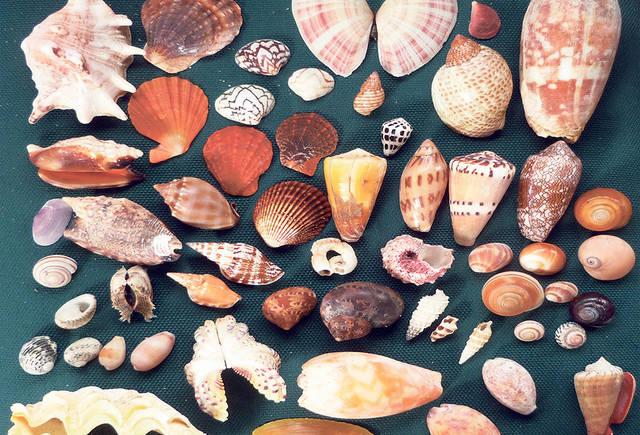Published in the Ocean Watch column, Honolulu Star-Advertiser © Susan Scott
June 3, 2017
BRAMPTON ISLAND, QUEENSLAND, AUSTRALIA >> The combination of afternoon low tides and Cyclone Debbie’s recent stirring up of the ocean floor has sparked a new passion in me: snails.
Like all beach walkers, I’ve always enjoyed finding pretty seashells, and like all biologists, I learned about the animals called mollusks. But never have I seen snails and homes like I have this week.

Snail species, or gastropods, are abundant in the waters off Australia. The shell at upper right is from a Conus geographus, a cone snail that can kill a person with its sting. However, the sand-filled shell was indicative that the snail inside was long dead and, therefore, was safe to pick up. ©2017 Susan Scott
Australian waters host countless snail species. Really countless. One local book claims that more than 10,000 species live here. Another shell guide reports tens of thousands.
Marine mollusks include octopuses, cuttlefish, squids and sea slugs, but those shell-less creatures don’t leave much of a legacy after they die. What gets us beachcombers excited is finding the jewel-like homes of two-shelled creatures we call clams and oysters (bivalves), and the one-shelled creatures we know as snails (gastropods).
Most people don’t include the word “snail” when talking about a shell they’ve found, but that overlooks the animal that built the stunning piece. Of the billions of empty shells cast ashore on the world’s beaches, each has its own life story.
Most snails begin their lives as tiny hatchlings that swim for days or months before settling on the ocean floor. Soon after, the baby snail’s glands secrete a hard, calcium carbonate covering, the beginning of the adult animal’s shell, around its soft body. As the animal grows, its glands enlarge the shell along its outer edge, often in a spiral.
A snail doesn’t add shell material evenly, but rather lays it down in precise places to create its own species’ shape, thickness, height and diameter. At the same time, the creature’s glands introduce pigments into the calcium carbonate that show up on the shell as spots, lines or other markings unique to the species.
Snails don’t enlarge their shells continuously, but do it in spurts. On some spiral shells you can see growth lines called sutures. In adult snails the inside whorls of broken shells reveal the snail’s nursery and its rooms during adolescence.
Besides being superb architects and sculptors, snails are math geniuses. The complex calculations of depositing each molecule of shell and each speck of color in the precise right place at the precise right time to create a species’ exclusive shell is unfathomable.
During a stretch of bad weather, we parked Honu in a marina, rented a car and drove to central Queensland to see Australia’s sapphire gem fields. The sapphires in the shops were OK, but I didn’t buy any. I prefer jewels made by snails.